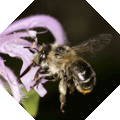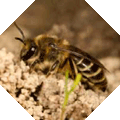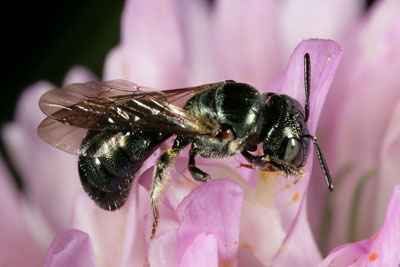|
|
Back to Pollinator Conservation
 Bombus sp. |
 Apis mellifera |
 Anthophora terminalis |
|
 Colletes inaequalis |
||||||||||
| Bumble Bees | Honey Bees | Digger & Long- Horned Bees |
Carpenter Bees | Mining Bees | Leafcutter & Mason Bees |
Sweat Bees | Polyester Bees |
|
thumbnail photos from Wild pollinators of eastern apple orchards and how to conserve them (Cornel University 2012) except A. terminalis (Laura Gooch) |
|
|
Types of Bees Most of these bees are native. The honey bee is introduced. Learn how to identify the bees in your garden or landscape! |
|
|
|
Bumble Bees (Bombus species; Family Apidae, Subfamily Apinae) These large (10 to 23 mm), hairy bees are the only truly social bees native to the United States. Overwintering queens form new colonies in the spring and nest in the ground. Bumble bees are used commercially to pollinate crops such as tomato. Pollen is carried on the hind legs on corbiculae (enlarged areas surrounded by stiff hairs). A few species invade the nests of other bumble bees; these social parasites do not carry pollen. See also Bumble Bees of the Eastern United States (USDA FS 2011) |
|
|
|
 Honey Bee (Apis mellifera) David Cappaert, Michigan State University, Bugwood.org |
Honey Bees (Apis
mellifera; Family Apidae, Subfamily Apinae) Honey bees are an introduced European species and are used commercially for honey, beeswax, and propolis production, as well as for pollination. They are 10 to 15 mm in length and possess corbiculae. Unlike other bees, honey bees live through the winter (but in the absence of the males or drones). Feral honey bees nest in trees or other cavities. Most honey bees are relatively docile; but an African subspecies (Apis mellifera scutellata), which escaped into the southern United States, is highly aggressive. |
|
|
|
|
|
Digger and Long-Horned
Bees
(Family Apidae, Subfamily Apinae) Digger bees are sometimes classified in the family Anthophoridae along with the carpenter bees. These hairy bees range from 5 to 25 mm in length and, like other members of this family, the females use scopae (stiff hairs) to carry pollen. Most species nest in the ground or in vertical banks, often in sandy soil. Some species waterproof their brood cells with secreted waxy or oily material. Most are solitary; however, some species may aggregate or share common entrances to nesting areas. Each female cares for her own brood. Males of Anthophora, Eucera, and Melissodes may sleep in groups while clinging to plant material with their mandibles. One species, Habropoda laboriosa, is an important blueberry pollinator. |
 Long-Horned Bee (Melissodes bimaculata) Johnny N. Dell, Bugwood.org |
|
|
|
|
 Small Carpenter Bee (Ceratina species) Steve Nanz, University of Minnesota Extension Gardening Info |
Carpenter Bees
(Family Apidae, Subfamily Xylocopinae) Large carpenter bees (Xylocopa species) are 13 to 30 mm in length and small carpenter bees (Ceratina) are 3 to 15 mm. Females use scopae to carry pollen. Xylocopa species chew nests in wood (including buildings!) and stems of plants. Ceratina species have smaller jaws; therefore, they utilize softer material, such as dead wood, in which to nest. Most carpenter bees are solitary, but a few species are semisocial (mothers and daughters share nests). |
|
|
|
 Mining Bee David Cappaert, Michigan State University, Bugwood.org |
Mining Bees (Family Andrenidae) These mostly solitary bees can be as small as 2 mm or as large as 25 mm. All species nest in the ground, especially on slopes, where large numbers of bees may aggregate. They are common in the early spring. Some species are important apple pollinators and can move more pollen than honey bees can! |
|
|
|
|
|
Leafcutter and Mason Bees (Family Megachilidae) This is a diverse family of 3 to 20 mm solitary bees that usually nest in cavities (beetle tunnels in dead trees, crevices, etc.). However, cuckoo bees in the genera Stelis and Coelioxys are cleptoparasites (nest in other bee's nests) and may even kill the host bees' larvae. Leafcutter bees (Megachile species) cut sections of leaves and flowers to wrap brood cells, while mason bees (Osmia species) use mud to divide brood cells. Other genera and species may use materials such as plant hairs, pebbles, wood. Bees in this family collect pollen on hairs on the underside of the abdomen instead of on the legs. The blue orchard bee (Osmia lignaria) is an important pome fruit pollinator. |
 Blue Orchard Bee (Osmia lignaria) Scott Bauer, USDA Agricultural Research Service, Bugwood.org |
|
|
|
|
|
|
Sweat Bees (Family Halictidae) These small bees are sometimes brightly colored and may be 3 to 23 mm depending on species. Most are solitary and nest in the ground or in wood, but some Lasioglossum species exhibit social behavior. Some Sphecodes species are cleptoparasites (nest in other bees' nests). |
|
|
|
|
|
Polyester Bees (Family Colletidae) These 5 to 15 mm solitary bees nest in the ground or in wood and line the insides of the cells with a substance that resembles cellophane. Colletus and Hylaeus are two common genera. Although solitary in nesting behavior, they may aggregate. |
|
|
|
|
|
Social and Potter Wasps
(Family Vespidae) A number of wasps may be confused with bees. Paper wasps, hornets, and yellowjackets are large (up to 25 mm) social wasps that nest in cavities, trees, and often eaves of buildings. Yellowjackets also nest in the ground and are particularly prone to stinging if nests are disturbed. Yellowjackets frequently steal food and beverages from picnickers in late summer. Potter wasps are solitary vespids that construct nests with mud or utilize cavities or ground tunnels. Most vespids are predators and hunt other insects to feed developing larvae. |
|
|
|
|
|
Digger, Sand, and Mud-Dauber Wasps
(Family Sphecidae) Spider Wasps (Family Pompilidae) Other solitary wasps nest in the ground or in cavities and provision nest cells with paralyzed insects or spiders. One familiar species is the cicada killer (Sphecius speciosus), which hunts cicadas. Mud-daubers use mud to construct brood cells and can be found alongside buildings. Solitary wasps usually do not sting humans unless handled or threatened. |
| Value of Bees * Bees & Pesticides * CCD * Conservation * Plants for Pollinators * Bumble Bees * EPA * European Union * Workshop * Research | |
Back to
Pollinator Conservation
 |
(C) Regents of the University of
Minnesota. All rights reserved. |
 |
 |